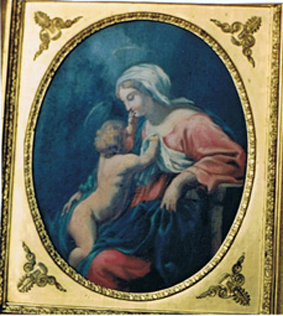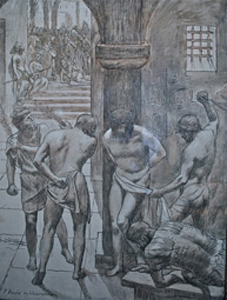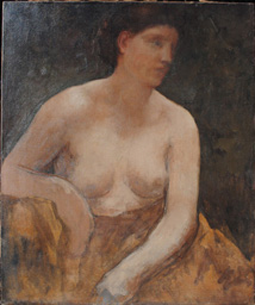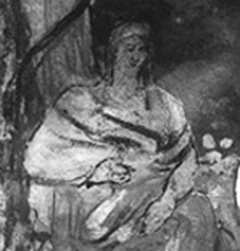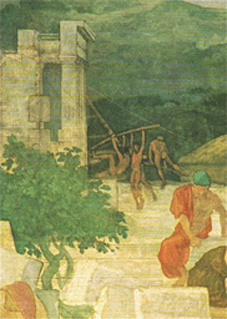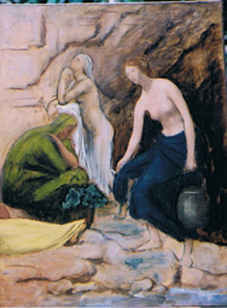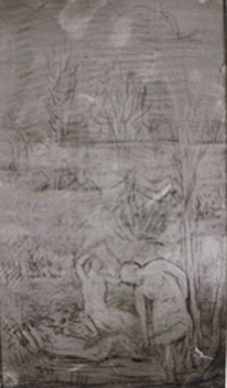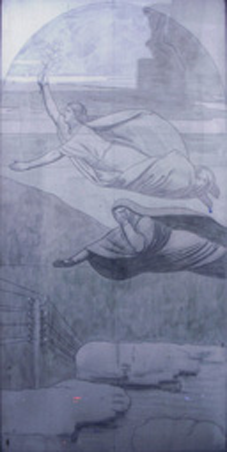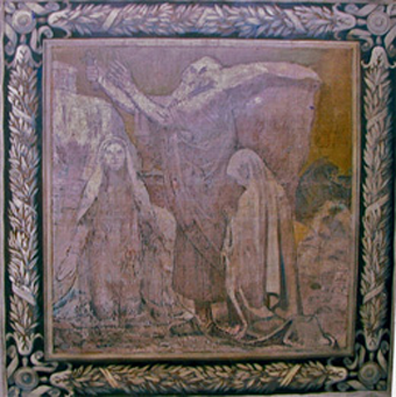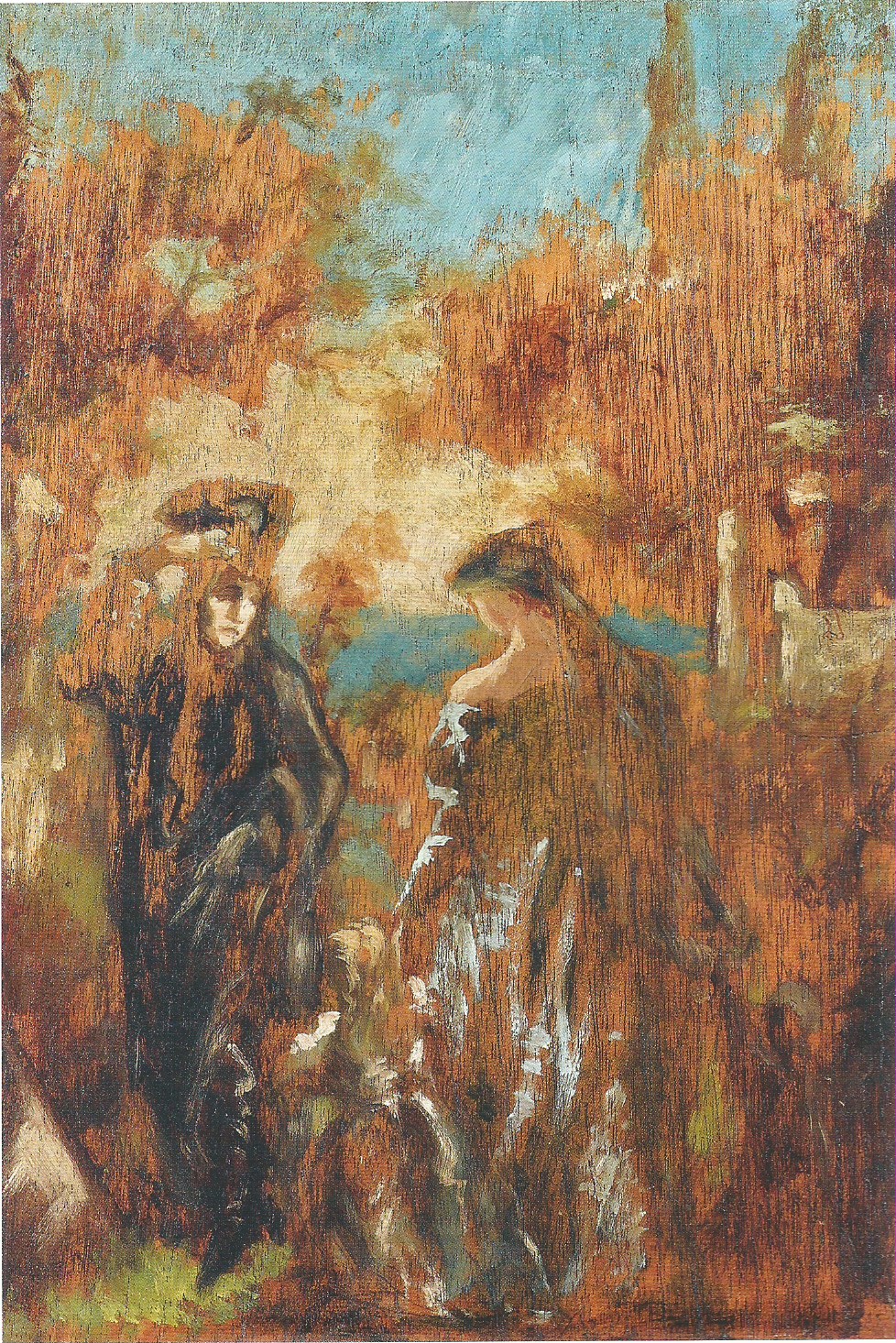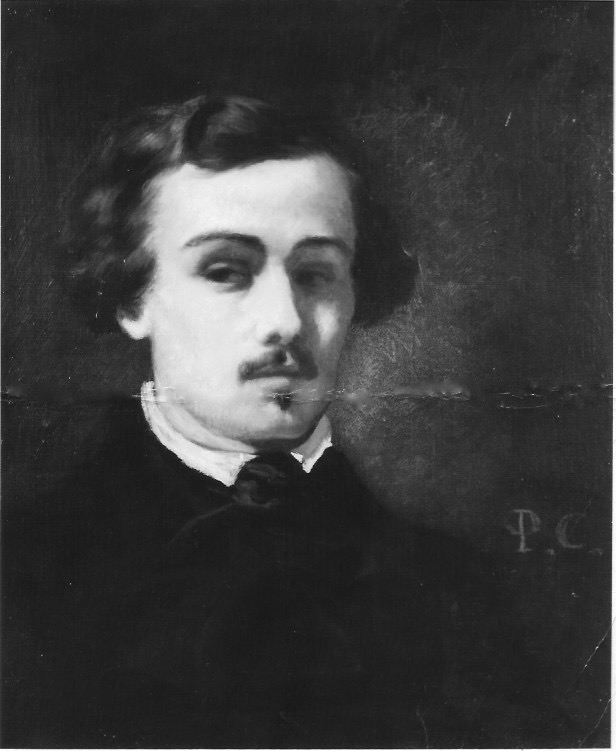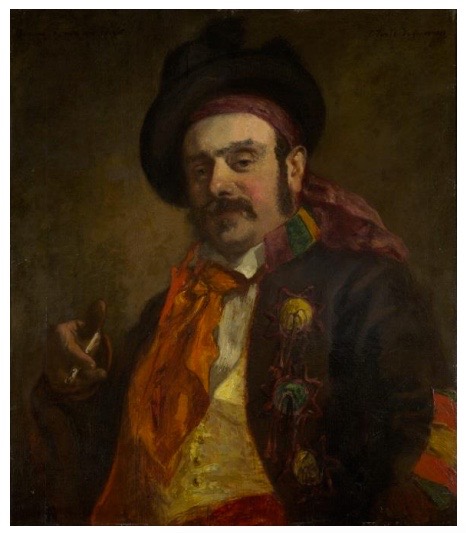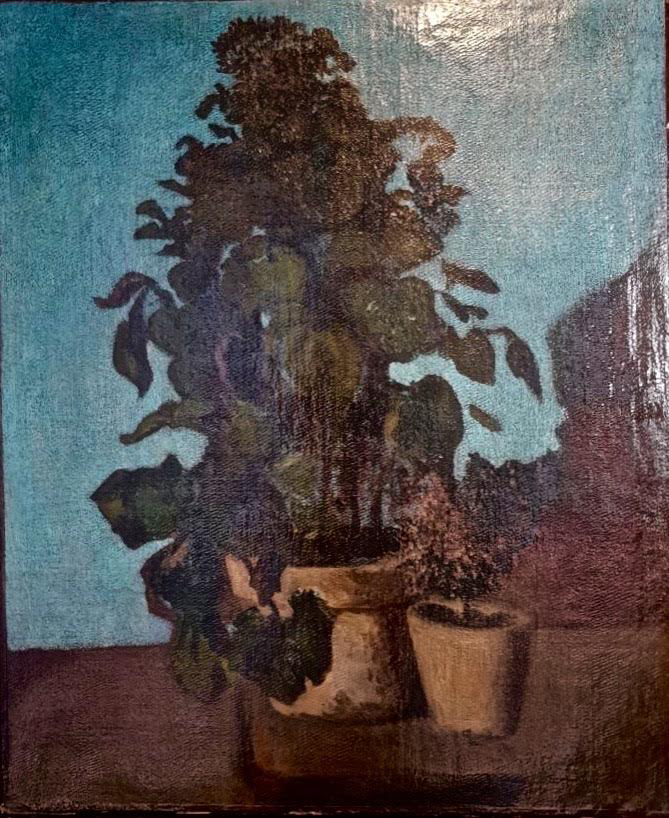|
|||
|
Paintings by Pierre Puvis de Chavannes unlisted in the Catalogue Raisonné Research by Bertrand Puvis de Chavannes 1 - Virgin and Child, 1848. Oil on panel, 32.5 x 26 cm.
Monogrammed P.C. dated 48. The painter gave this work to his niece Claude Aimée Vincent de Vaugelas in 1881 on the occasion of her marriage to M. V. H. Monroe. (Puvis’ signature appears as witness on the marriage certificate). It bears the rare monogram PC that is hardly ever used by Puvis like the monogram PPC inscribed in red on his three early paintings (N°14, N°15, N°16 of the Catalogue Raisonné.). It is a copy of Simon Vouet’s La Vierge accoudée most probably based on the etching by Daret. .
Oil on canvas, 48 x 38 cm.
Estate seal on the stretcher. Provenance: Estate of the artist. France, private collection.
Oil on canvas, 70 x 57 cm.
Estate seal on reverse. Provenance: Estate of the artist. France, private collection.
Diluted brown oil wash, pencil, white wash on canvas, 81.5 x 61 cm.
Provenance: Bernheim Jeune; J. Gillet collection; France, private collection. Related work: Drawing on transfer paper, study for the background, France, private collection. This painting is mentioned and reproduced as a drawing in the catalogue (N°86 f)
Oil on canvas, with pen and ink outlines. 48.2x71.5 cm.
Signed “P. Puvis de Ch”, lower left. Provenance: Suzanne Valadon; her son Maurice Utrillo; sale Pierre Cornette de Saint-Cyr, Hôtel Drouot, Paris, 7th June 1994, lot 24; Jean-Luc Baroni Gallery; Private Collection, Paris. Exhibited: Musée Utrillo-Valadon, La vie de bohème, February 2000, exhibition catalogue N°49, p. 57, illustrated. Brown Price thinks that this sketch (“present whereabouts unknown”) asks for further study (cat. FS7). Its composition is very similar to that of the final version in Amiens, in which Puvis did not retain the idea of two silhouettes in water. However, he clarifies in it the idea of the laborers, in the background on the right, suggested by the presence of an ox. This painting comes after the sketch of the Barbazanges gallery (cat. N°107). Here Puvis had already abandoned the idea of including a boat in the background of Work, to the right. The devices of trees on the left, the beams, the stumps in the foreground, the anchor at the feet of the workers lead us to understand the purpose of the workers’ activities: the construction of a boat. These devices missing in this sketch FS7 are present in the final version in Amiens.
Oil on canvas, 65 x 54.5 cm.
Provenance: Adrien Karbowsky, René Karbowsky, Jacques Karbowsky. Drouot sale, Paris, 10/06/1994, N°52. Drouot sale, Paris, 30/06/1997, N°21. France, private collection. Exhibitions : Durand-Ruel, Paris, 1899, N°22 ; Autumn exhibition, Paris, 1904, N°40 ; Musée de Picardie, Amiens, 2005-6, N° 89. According to Brown Price, this painting is one amongst those that need to be researched more extensively (cat. FS13). It is difficult to understand her reasoning: Doubtful logic right from the exhibition section: Durand-Ruel 1899 (…)N°22. “The medium is not indicated but it is classified in the painting section.” The medium is also not indicated for other works listed in this section. They are undoubtedly paintings. Autumn Exhibition, 1904, N°40. (“The medium is not indicated but the designation “drawing” appears under other entries.”) The drawings in question, lent by Karbowsky, have been identified as drawings. Bust of a Woman along with the other entries are thus paintings. In both cases Bust of a Woman is presented as belonging “to Mr. Karbowsky”. We regret that Brown Price did not think it was worth mentioning this in her catalogue. According to her the subtly modulated pale skin standing out against a dark background is reminiscent of Puvis style of the 1890s. It reminds us, rather, of the Portrait of a Woman in Profile from the years 1855-65 (cat. N° 64) or the Portrait of a Woman in Pink of 1865 (cat. N°137). She does not also see any resemblance with other works and “the position of the arms in front of the body is not entirely satisfactory, their rendering is awkward and one arm emerges from nowhere.” The drawing of the arms, though, is well executed and in the same position as in the sketch for Autumn in the National Gallery of Prague (cat. N°123). Brown Price says that the figures in the Prague painting are very graceful. The similarity between Autumn and Bust of a Woman is obvious to me when I compare the orientation of the face and the hair style of the woman. She too is without a veil. Cf the pencil sketch personifying Autumn in the Beaux Arts Museum, Lyon. Dessin, Musée de Beaux-Arts, Lyon
Oil on canvas, National Gallery, Prague
Brown Price finds that Bust of a Woman has certain similarities with a seated woman in Le jardin du prieuré painted by Adrien Karbowsky in 1894 for the town hall of Enghien. The problem is that the resemblance is far from being striking and the technique is radically different. It is also rather puzzling as to why Karbowsky would have painted in 1894 on a canvas which according to Edouard Déchelette a specialist restorer of supports at the Louvre consulted in 1999, dates from the years 1860s. She also wonders why Puvis did not sign and dedicate this work to Karbowsky as he did for his friends. So we should wonder why he did not dedicate his works to his nephew Louis de Vaugelas (cat. N°16), his brother Edouard (cat. N°18), his friend Thomas Alfred Jones (cat. N°20), his sister (cat. N°24, cf Parutions du comité PPC), his niece (cat. N°90), his student Daras un Portrait of a Woman (cat. N°293) or to Théodore Duret La Bresse (cat. N°325)? In fact Puvis dedicated few of his sketches. Brown Price acknowledges in her notes that Puvis de Chavannes offered at least one drawing and two pastels to Karbowsky. All of them (not systematically with a dedication) have been identified: a pastel (Woman and Child on the Seashore 35 x 27cm, Drouot 13/12/1999), two watercolours, a pastel and oil on canvas (cat. N°194), and Bust of a Woman. Most of these works were displayed on the “Puvis wall” installed by René Karbowsky in his father’s house. René Karbowsky. The Puvis Wall, Oil on cardboard , 32.5 x 25 cm.
Let us conclude with Mathieu Pinette curator of the exhibition Puvis de Chavannes. Une voie singulière au siècle de l’Impressionnisme. (Picardie Museum, Amiens, 2005-06): “The sculptural aspects and the modeling of this powerful image prefigures the famous Madeleine of Budapest, painted thirty years later, in 1897. This figure, painted as early as the 1860s, announces the amplitude of Picasso’s figures of the 1920s.” 7-Study for Massilia, Greek Colony, ca 1868-69Pencil, blurring, brown wash on paper, 79.8 x 99 cm. Estate seal on reverse.
The painter noted on the back:”Groupe de constructeurs tirant sur l’ échelle”. (Team of builders pulling on the ladder.) Provenance: The artist’s heirs; Tajan, Drouot, Paris; Colnaghi Gallery; USA, private collection. Originally the drawing was pasted on canvas. It is most probably N°15 of Maître Delapalme’s inventory (1899). Brown Price rejected this work on the grounds that it was impossible to establish a connection between the subject of this drawing and any work by Puvis de Chavannes. Although it was identified by Bertrand Puvis de Chavannes as authentic. This drawing on tracing paper is a reversed study for the builders of the temple of Diana in the background of Massilia, Greek Colony.
After a meticulous examination of this painting in 1992, we confirmed its authenticity. The handling of the paint and brushwork is that of the 1880s.
Oil and chalk on paper pasted on canvas, 40 x 24.5 cm. Oil on canvas, 62 x 46 cm.Estate seal on reverse. Provenance: Estate of the artist. France, private collection.
We see no valid reason not to accept this as part of the Puvis’ corpus. This painting, which comes from the estate of the artist, seems to be a study for one of the Muses in La Sorbonne.
Oil on canvas, 35 x 26 cm.Estate seal on reverse. Provenance: Estate of the artist.Germany, private collection.
Charcoal on canvas, 135 x 75 cm. Estate seal on reverse. Provenance: Estate of the artist.Germany, private collection
Oil on canvas, 58 x 30.5 cm.Estate seal on reverse. Provenance: Estate of the artist.France, private collection. Exhibition: De Puvis de Chavannnes à Fantin Latour 1880-1920/ Le Symbolisme. Villefranche, Paul Dini Museum, 2010, N°15, reproduced.
Charcoal, pencil, brown wash on canvas, 123 x 62 cm. Estate seal on reverse Provenance: Estate of the artist; changed hand in 2006. France, private collection.
Oil on canvas, 70 x 70 cm.Estate seal on reverse.
France, private collection. Refer to N° 244 of the catalogue raisonné.
Oil on cardboard, 31.7 x 18.8 cm.
Provenance: Former collection of the American painter Frank Holman. Exhibition: Amiens, 2005-06, N°223. Brown Price doubts the authenticity of this painting. (Cat. FS17) Both of her arguments are contestable. “Puvis has rarely done these kinds of small sketches.” A quick overview of the small sketches in the catalogue refutes this. “This could be a copy made by the American painter Holman.” The problem is that this small canvas shows all the characteristics of a sketch rather than a copy. It is also to be noted that in the case of a copy, the inclusion of the border would be unnecessary. It appears that this project is executed by Puvis himself. As noted by Louise d’Argencourt, Puvis "showed a rare and unusual tendency to paint night scenes.” (Catalogue of the exhibition Puvis de Chavannes, 2005-06, Picardie Museum, Amiens, N°223).
Oil on canvas, 73 x 61 cm.
Signed "Puvis de Chavannes" and dated 1887 lower left. On the frame is handwritten number 1426, who corresponds very certainly to the one which appears on a brief inventory of the works of Pierre Puvis de Chavannes of the Gallery Durand-Ruel in New York, on December 27th, 1895, ( as a Pity), with cross-reference to number 3120 of Paris gallery On a statement sent to the painter by M.M. Durand-Ruel and Son dated August 31st, 1895, number 3120 corresponds to one Charity quoted 15000 francs.
Oil on panel, 35,79 cm x 24,2 cm
Audap-Mirabaud Drouot, 04/06/2014, reproduced p. 11.
Oil on canvas.
Whereabouts unknown.
Oil on panel, 53,8 x 65 cm.
Signed P. Puvis de Chavannes, lower left. Nice, private collection. Unfinished copy of Bacchanale des Andriens, by Titien (Prado Museum, Madrid). Puvis has never been in Spain. That copy has probably been made from a reproduction. Among the painter ’s early works, Julian quotes a Bacchanale.* Realized from an ochre preparation, the style is typical of the 1850.s. Aimée Brown-Price attributes another Bacchanale to Puvis. (Cat FS1). Although exhibited in Lyon’s (1937) and Bourg-en-Bresse (1954). that painting can’t be painted by Puvis de Chavannes. The technic does not correspond to any manner of Puvis, even in the 1850s. * René Julian. L’oeuvre de jeunesse de Puvis de Chavannes. Gazette des Beaux-Arts, november 1938, p.240
Oil on panel, 73 x 62 cm.
Signed P. Puvis de Chavannes, upper right.Inscribed upper left: A mon ami Forget. Nice, private collection. Localization of this work is unknown to Aimée Brown-Price; she mentions it among the works « attributed" to Puvis (Cat. FS 4). In the collection Cligman since the beginning of 1970s, it was given to the abbey of Fontevraud in 2017. Julian compares the Jardinier du Brouchy to this portrait *, which is unmistakably by the hand of Puvis. * René Julian. L’oeuvre de jeunesse de Puvis de Chavannes. Gazette des Beaux-Arts, november 1938, p.240
Oil on canvas, 64 x 53 cm.
Seal of red wax on reverse. N°53 of the inventory (november 14th 1898) | |||

